Wicca in the Real World
 Sean Trayner
Sean TraynerHow an “evangelical atheist” found faith in an unusual place
Sam Wagar always knew he had a religion. But growing up, he never really knew what it was.
33 years ago, Wagar called himself an “evangelical atheist.” He spent his 20s convincing others to denounce their “blind faith,” and preaching that no god or “Supreme Being” existed. He was pleased being an atheist, and tried to persuade others to reject their religion and do the same.
But when Larry Smiley, Wagar’s close friend and father figure, died in February 1982, Wagar had a “conversion experience.”
Smiley’s family asked Wagar to serve as a pallbearer at his Roman Catholic funeral. Despite his beliefs towards faith and religion, he accepted.
Wagar respectfully sat through the cycle of prayers and the Absolution of the dead led by the parish priest during the ceremonies. When the Catholic priest spoke about how “great it was that (Smiley) was dead so he could be with Jesus,” Wagar disagreed, and thought to himself that Smiley should be there with them, instead.
After Smiley’s burial, Wagar caught up with Smiley’s girlfriend and reminisced on his close friend’s life. It was at that moment that Wagar became aware there was still a sense of connection between him and his lost mentor, which led him to question his atheism.
“I felt that atheism was completely inadequate when it came to death,” Wagar says, recalling his departure from his ideologies. “I didn’t feel like (Smiley) ceased to exist. Atheism suggests that you only have relationships with people who are alive … but I didn’t feel like my relationship with (Smiley) as my friend had gone away.”
While on the train home to Surrey, BC after Smiley’s funeral, Wagar started writing poetry to the Mother Goddess, one principle of the great Wiccan Goddess. She is described as the Maiden, the Mother and the Crone, each representing stages of the female life cycle. He says it’s hard to explain, but he felt the presence of a “comforting spiritual force that was explicitly female,” and he began to explore it.
Wagar then inquired about the Wiccan religion to a friend who he knew was a High Priestess of the Wiccan Church of Canada, who gave him Starhawk’s first book, The Spiral Dance. Wagar then researched the rudiments of Wiccan ritual and theology. From there, “it all made sense, and continued to make sense.”
Wagar related to the polytheistic stream of Wicca, which worships thousands of gods, and subsequently became a Third Degree Wiccan High Priest in 1985. The once-staunch evangelical atheist had finally found his religion.
As a high priest, Wagar turns ordinary rooms into sacred spaces by symbolically sweeping out any negative energy, then drawing a circle boundary with his finger. He assigns the elements of earth, fire, wind and water in four directions, and then calls the gods to be present with them to participate in song, chat, ritual and spells.
While in service, Wagar often goes into a “trance experience,” which enables a direct connection with gods or goddesses, who come into his body, speak through his lips and take total control of his limbs.

Wicca is a decentralized religion, as many Wiccans develop their own beliefs and rituals. But although some Wiccans practice in solidarity, they all emphasize the importance of the feminine being as important as the masculine, the preservation of the environment, positive attitude towards human sexuality as a gift to the Goddess and the passage of seasons.
Wagar, who practices in a coven, hopes to spread that message at the University of Alberta where he’s serving as the institution’s first ever Wicca chaplain since September 2014.
The U of A Chaplains Association hosts 14 chaplains, including a Catholic, Muslim, Buddhist and Jewish chaplain. While it’s typical for post-secondary institutions to accommodate “mainstream” faiths, Wagar supports a more “unknown” minority religion. In the Government of Canada’s 2011 National Household Survey, only 10,225 Canadians and 1,535 Albertans identified as Wiccan.
Wagar says when he tells someone he’s Wiccan, they usually try to convert him to Christianity or ask him if he worships the devil. After 30 years of acting as a Wiccan high priest, Wagar doesn’t get offended when people find him and his religion odd or bizarre.
“Well, they’re right,” Wagar says. “Wicca is unusual in that all of our clergy people are expected to have mystical trance experiences. So yeah, that is mysterious and weird.”
But “mysterious and weird” doesn’t necessarily mean evil, like the stereotypical long-nosed, pointy-hat-wearing, black magic-performing antagonist wenches that eat children in TV and fiction.
“A lot of what people think about Wicca come from fairy tales or from Disney,” he says. “We’re probably the only religion in the world that has the Wicked Witch of the West from The Wizard of Oz and Disney characters defining the notion of who we are.
“We aren’t interested in cursing people and we’re not based on somebody’s fantasy life … It’s all a load of crap.”
Wiccans also don’t associate with Satan, endorse sexual assault or sacrifice cats. But they do perform rituals, such as blessing objects for protection or fertility spells for harvest growth. Some Wiccan rituals do require an athame, a double-sided knife, but not to harm — they’re used as a beacon of energy in some spells.
And when Wagar arrives on campus, he takes the bus — not a magical flying wooden broom. The only symbol Wiccans hone is an upright pentagon, with each point representing earth, air, fire, water and the spirit, which ties the four elements together.
And the colour black?
“I have been told that many priestesses like to wear the colour black because it’s slimming,” Wagar says with a chuckle. “It’s a good neutral colour and easy to work with. I have a black robe, but only because I was given one.”
In addition to serving as the U of A’s Wiccan Chaplain, Wagar is also the High Priest of the Congregationalist Wiccan Assembly of Alberta’s Ravenwood Temple, located in Edmonton.
As a high priest and chaplain, Wagar’s goals include assisting the U of A’s Wiccan and Pagan community spiritually, working with other faiths and educating and informing others about the basic beliefs of Wicca.
While there is a large mainstream religion population at the U of A, Wagar has been supporting a “small group” of students, faculty and staff who ascribe to Wicca. Many of them have yet to “step out of the broom closet,” and publicly declare their faith out of fear of discrimination, Wagar says. But they’ve been “delighted” to have a Wicca chaplain for the first time, especially if they start to question their faith, just like Wagar did 33 years ago.
“You don’t want people to think you’re odd when you’re just trying to find your way,” Wagar says. “People aren’t as comfortable coming out of the closet as Wiccan. I’m here to offer that support.”




